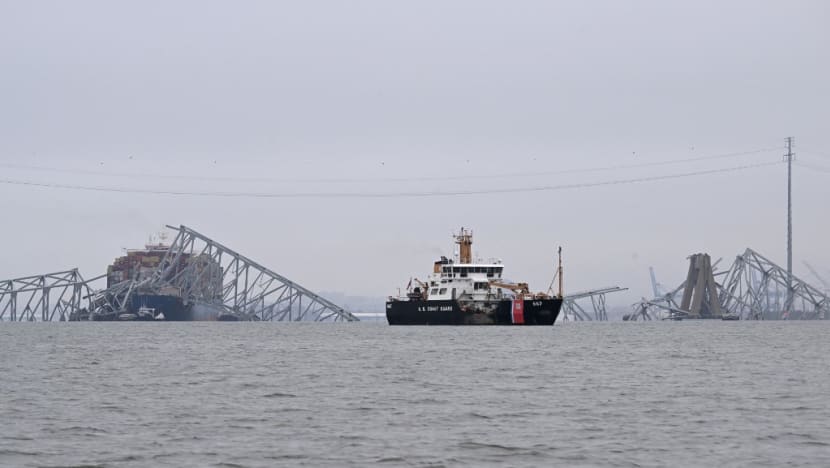What will be the focus of investigation into Baltimore bridge collapse?
One of the most important questions as a matter of law was how close to the bridge was the ship when the power failures occurred, said an international authority on maritime law.

A US Coast Guard vessel patrols near the collapsed Francis Scott Key Bridge after it was struck by the container ship Dali in Baltimore, Maryland, on Mar 27, 2024. (Photo: AFP/Jim WATSON)

This audio is generated by an AI tool.
As the Baltimore bridge operations move from recovery to salvage, investigations are likely to focus on whether the vessel involved - Singapore-flagged container ship Dali - was seaworthy, experts told CNA.
This includes factors such as the type of fuel used onboard and the condition of the engines, they said.
The investigations are typically complex and could take up to a year, said one expert.
This comes as details have emerged about what happened in the minutes leading to the Dali slamming into the Francis Scott Key Bridge and bringing it down almost entirely, based on preliminary findings from the ship's voice data recorder.
The United States National Transportation Safety Board (NTSB) will examine whether contaminated fuel played a role in the ship's power loss.
As of Thursday (Mar 28), six of an eight-man construction crew who were filling potholes on the bridge when the crash happened were believed to have been killed, with four bodies yet to be found.
Who is likely to be held responsible?
If contaminated fuel was the cause of the problem, the ship owner would “clearly be responsible” for the incident, said Professor Martin Davies, an international authority on maritime law, which is also known as admiralty law.
The owner has an obligation to make sure that the ship is seaworthy for any voyage, which includes a range of different aspects of the ship's ability to safely perform the voyage, Prof Davies, who is director of the Maritime Law Center at Tulane University, told CNA’s Asia First on Thursday.
He added that if the vessel was determined to be unseaworthy, either because of the fuel or because of the condition of the engines, then it is likely that the ship owner would be held at fault, and it would then be unable to limit its liability under US law.
The Dali is owned by Grace Ocean Pte Ltd, a Singapore-based company that provides water transportation services. The ship's management company is Synergy Marine Group.
Related:
Did the crew take the right steps before the incident?
One of the most important actions taken by the crew was to declare Mayday, as this ensured that a signal was sent out to the authorities to ensure that traffic would be stopped, said Associate Professor Kenneth Low, cluster director for Engineering at the Singapore Institute of Technology (SIT).
The bridge was crossed by tens of thousands of motorists each day.
Furthermore, they decided to drop the anchor, he said. However, he noted that given that the vessel was so close to the bridge – barely two to three minutes away – at the point of losing power, it was not possible for it to halt in time, he said.
“The momentum required to come to a stop is tremendous. So, all actions were taken correctly, but unfortunately, because of the large vessel (and) the momentum and time required to come to a stop, unfortunately (they) could not prevent a collision,” he told CNA’s Singapore Tonight on Wednesday.
What will be the focus of the investigation?
One of the most important questions as a matter of law was how close the ship was to the bridge when the power failures occurred, said Prof Davies, adding that another question is to what extent this affected the ship’s ability to steer.
“They will be speaking to the members of the ship's bridge - that's the bridge on the ship, not the bridge that they hit - the crew who were on the bridge, the pilots … There will be many, many interviews of those people to try and discern as well as seeing the digital data that they have to what extent it was possible to steer the vessel at all if at all,” he said.
Assoc Prof Low said that the investigation can take up to a year, adding that such investigations are typically very complex.
How important are the issues reported following inspection?
Addressing reports that the vessel was inspected last year at a Chilean port and was found to have deficiencies, and also that ships belonging to the owner of the Dali have been flagged in the past for labour violations, Prof Davies said that these “will not be quite as significant as perhaps they sound”.
“The safety inspections for ships are very rigorous in most parts of the world,” he said.
“So, it's not all that unusual that the Dali encountered this issue in Chile. But clearly, it's relevant that the ship has encountered some inspection problems previously.”
What could possibly help in future?
If there is any procedure that could improve the process of massive vessels entering and leaving major ports, it would be ensuring that a tugboat accompanies vessels until they pass critical infrastructure, said Assoc Prof Low.
“If there's a loss of power, the tugboat will be able to control the vessel, so they'll still be able to move the vessel in the correct direction rather than total loss of control,” he said.














